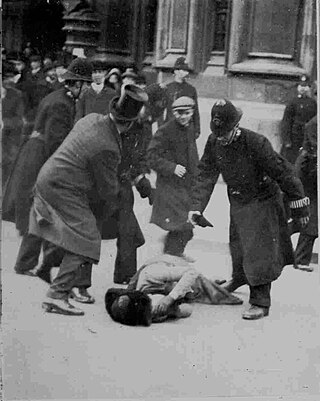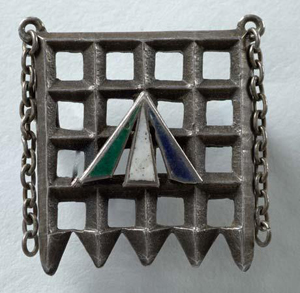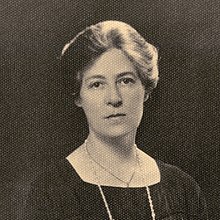
Dame Christabel Harriette Pankhurst was a British suffragette born in Manchester, England. A co-founder of the Women's Social and Political Union (WSPU), she directed its militant actions from exile in France from 1912 to 1913. In 1914, she supported the war against Germany. After the war, she moved to the United States, where she worked as an evangelist for the Second Adventist movement.

The Women's Social and Political Union (WSPU) was a women-only political movement and leading militant organisation campaigning for women's suffrage in the United Kingdom founded in 1903. Known from 1906 as the suffragettes, its membership and policies were tightly controlled by Emmeline Pankhurst and her daughters Christabel and Sylvia. Sylvia was eventually expelled.

Adela Constantia Mary Walsh was a British-born suffragette who worked as a political organiser for the Women's Social and Political Union (WSPU) in Scotland. In 1914 she moved to Australia where she continued her activism and was co-founder of both the Communist Party of Australia and the Australia First Movement.

Ann "Annie" Kenney was an English working-class suffragette and socialist feminist who became a leading figure in the Women's Social and Political Union. She co-founded its first branch in London with Minnie Baldock. Kenney attracted the attention of the press and public in 1905 when she and Christabel Pankhurst were imprisoned for several days for assault and obstruction related to the questioning of Sir Edward Grey at a Liberal rally in Manchester on the issue of votes for women. The incident is credited with inaugurating a new phase in the struggle for women's suffrage in the UK with the adoption of militant tactics. Annie had friendships with Emmeline Pethick-Lawrence, Baroness Pethick-Lawrence, Mary Blathwayt, Clara Codd, Adela Pankhurst, and Christabel Pankhurst.

Rachel Barrett was a Welsh suffragette and newspaper editor born in Carmarthen. Educated at the University College of Wales in Aberystwyth she became a science teacher, but quit her job in 1906 on hearing Nellie Martel speak of women's suffrage, joined the Women's Social and Political Union (WSPU) and moved to London. In 1907, she became a WSPU organiser, and after Christabel Pankhurst fled to Paris, Barrett became joint organiser of the national WSPU campaign. In 1912, despite no journalistic background, she took charge of the new newspaper The Suffragette. Barrett was arrested on occasions for activities linked to the suffrage movement and, in 1913–1914, spent some time incognito to avoid re-arrest.

Marion Wallace Dunlop was a Scottish artist, author and illustrator of children's books, and suffragette. She was the first and one of the most well known British suffrage activists to go on hunger strike on 5 July 1909, after being arrested in July 1909 for militancy. She was at the centre of the Women's Social and Political Union and designed some of the most influential processions of the UK suffrage campaign, as well as designing banners for them.

Teresa Billington-Greig was a British suffragette who was one of the founders of the Women's Freedom League in 1907. She had left the Women's Social and Political Union - also known as the WSPU – as she considered the leadership led by Emmeline Pankhurst and her daughters too autocratic. In 1904, she was appointed by the WSPU as a travelling speaker for the organisation. In Autumn 1906, Billington-Greig was tasked with drumming up support for branches of WSPU in Scotland. On 25 April 1906, she unveiled a 'Votes for Women' banner from the Ladies Gallery during the debate in the House of Commons. In June 1906, she was arrested in a fracas outside of Chancellor of the Exchequer H. H. Asquith's home, and as a result was the first suffragette to be incarcerated in Holloway Prison.

Flora McKinnon Drummond was a British suffragette. Nicknamed 'The General' for her habit of leading women's rights marches wearing a military style uniform 'with an officers cap and epaulettes' and riding on a large horse, Drummond was an organiser for the Women's Social and Political Union (WSPU) and was arrested nine times for her activism in the women's suffrage movement. Drummond's main political activity was organising and leading rallies, marches and demonstrations. She was an accomplished orator and had a reputation for being able to put down hecklers with ease.

Aeta Adelaide Lamb was one of the longest serving organizers in the Women's Social and Political Union (WSPU), the leading militant organization campaigning for Women's suffrage in the United Kingdom.

Mary Elizabeth Phillips was an English suffragette, feminist and socialist. She was the longest prison serving suffragette. She worked for Christabel Pankhurst but was sacked; she then worked for Sylvia Pankhurst as Mary Pederson or Mary Paterson. In later life she supported women's and children's organisations.

Mary Blathwayt was a British feminist, suffragette and social reformer. She lived at Eagle House in Somerset. This house became known as the "Suffragette's Rest" and contained a memorial to the protests of 60 suffragists and suffragettes. The memorial was bulldozed in the 1960s.

Jessica "Jessie" Kenney (1887–1985) was an English suffragette who was jailed for assaulting the Prime Minister and Home Secretary in a protest to gain suffrage for women in the UK. Details of a bombing campaign to support their cause were discovered by the authorities in her flat when Kenney was sent abroad to convalesce. She later trained as a wireless operator but worked as a stewardess.

Eagle House is a Grade II* listed building in Batheaston, Somerset, near Bath. Before World War I the house had extensive grounds.

Florence Eliza Haig (1856–1952) was a Scottish artist and suffragette who was decorated for imprisonments and hunger strikes.

Ada Cecile Granville Wright was an English suffragette. Her photo on the front page of the Daily Mirror on 19 November became an iconic image of the suffrage movement.

Maud Joachim was a member of the Women's Social and Political Union, one of the groups of suffragettes that fought for women to get the right to vote in the United Kingdom. She was jailed several times for her protests. Joachim was one of the first suffragettes to go on hunger strike when imprisoned, a protest at not being recognised as political prisoners.

Lucy Minnie Baldock was a British suffragette. Along with Annie Kenney, she co-founded the first branch in London of the Women's Social and Political Union.

Gladice Georgina Keevil was a British suffragette who served as head of the Midlands office of the Women's Social and Political Union between 1908 and 1910.

Lillian Dove-Willcox (1875–1963) was a British suffragette who was a member of Emmeline Pankhurst's personal bodyguard.

The Holloway brooch was presented by the Women's Social and Political Union (WSPU) to women who had been imprisoned at Holloway Prison for militant suffragette activity. It is also referred to as the "Portcullis badge", the "Holloway Prison brooch" and the "Victoria Cross of the Union".






















